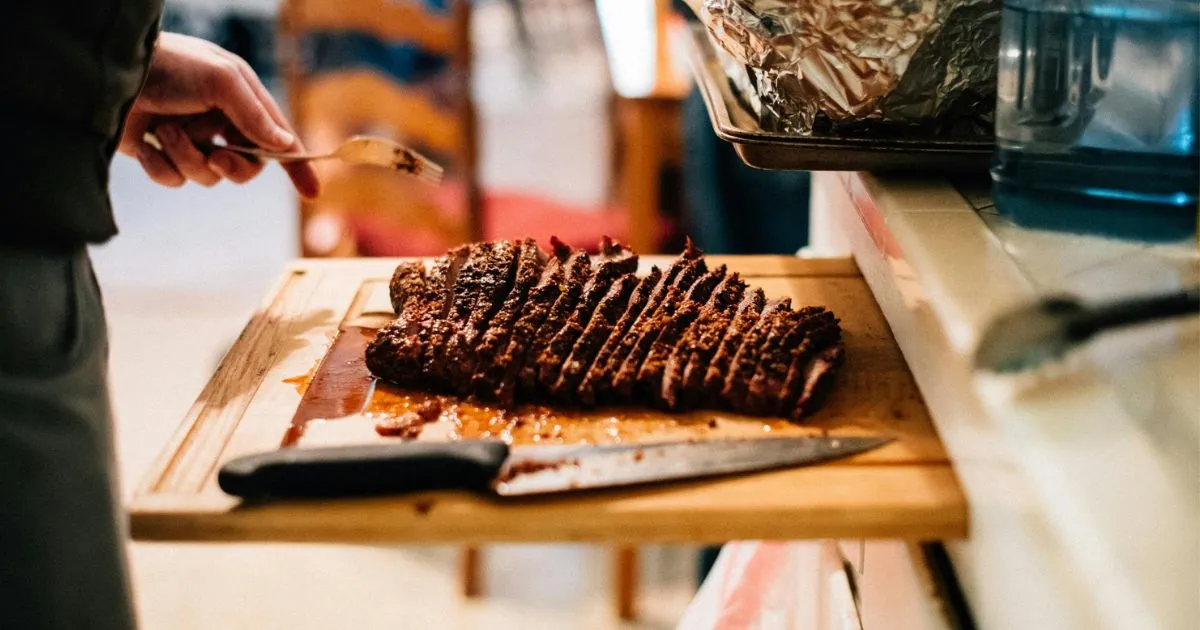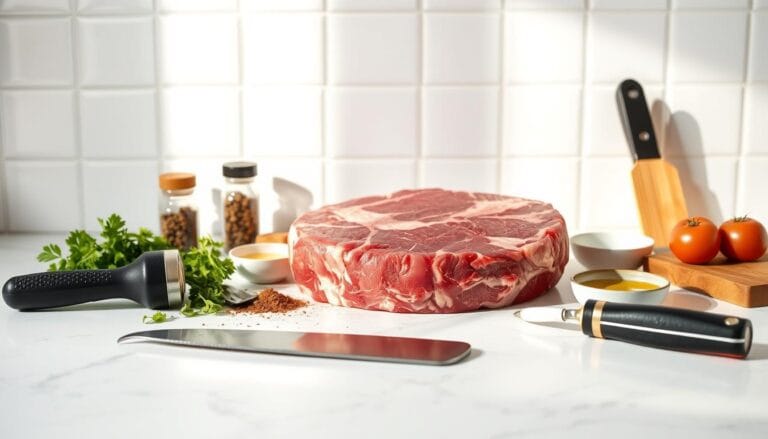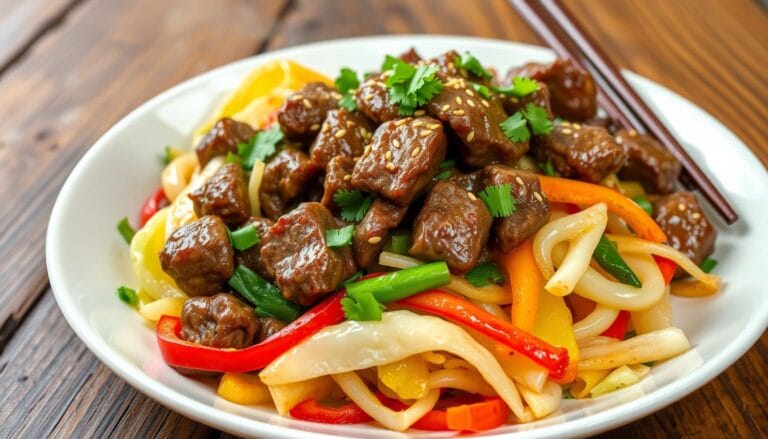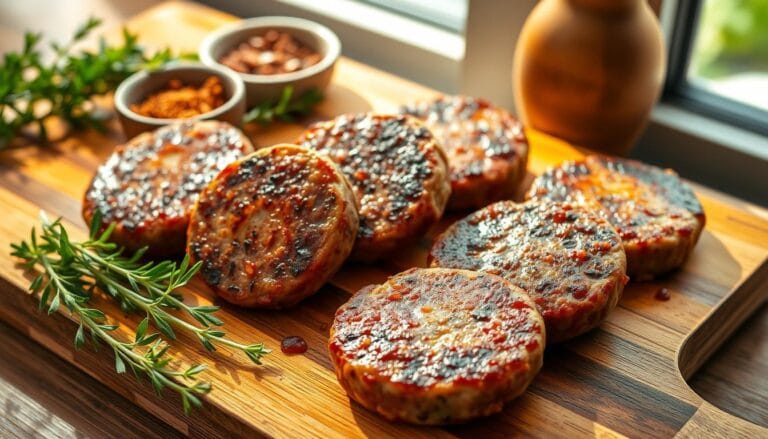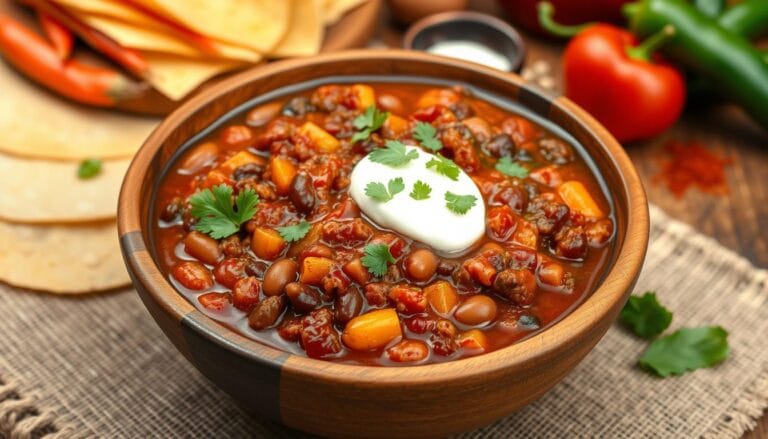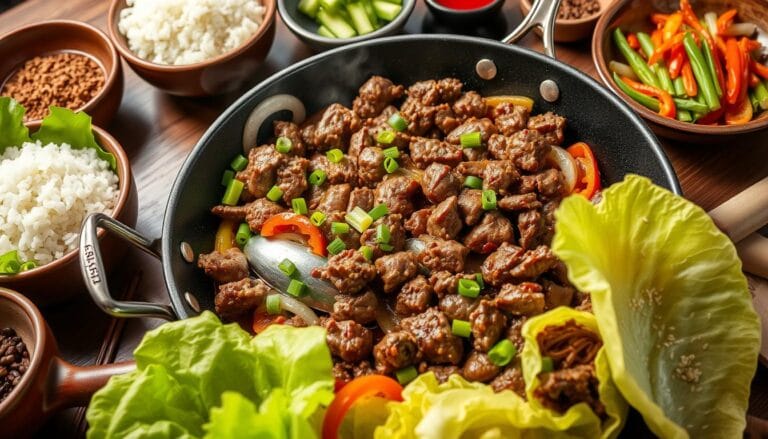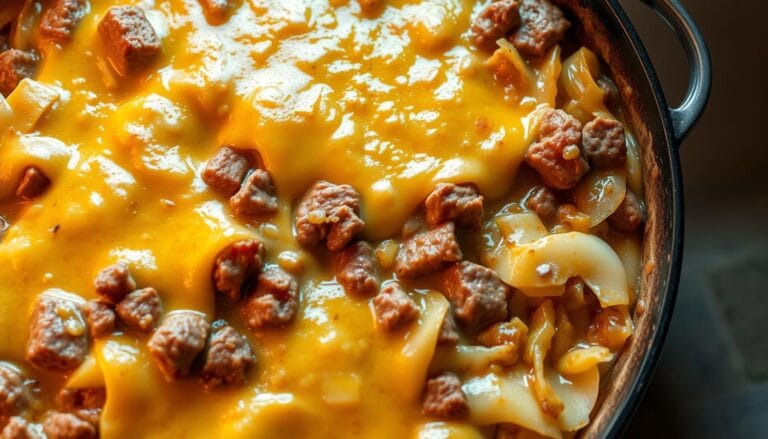“How to Make Corned Beef at Home
Table of Contents
Learning to make corned beef at home is rewarding. With the right recipe, you can make a delicious dish for any event. It’s great for both beginners and experienced cooks because you can choose the ingredients and control the cooking.
By following a simple recipe and using the right techniques, you can make a dish that will wow your family and friends. This guide will show you how to make corned beef at home. You’ll learn how to make it flavorful and tender, and discover the secrets to a perfect recipe.
Introduction to Homemade Corned Beef
Making corned beef at home is simpler than you might think. With the right guidance, you can make a delicious and authentic dish. First, you need to learn the basics, like choosing the right cut of meat and cooking techniques. With practice and patience, you can create your own unique corned beef recipe.
Key Takeaways
- Learning how to make corned beef at home can be a fun and rewarding experience
- Using the right corned beef recipe and techniques is key to creating a delicious and tender final product
- Making corned beef at home allows you to control the ingredients and the cooking process
- With practice and patience, you can create a perfect corned beef recipe that’s all your own
- Understanding the basics of how to make corned beef is essential to creating an authentic and delicious dish
- Using the right cut of meat and proper cooking techniques is crucial to making great corned beef
- Experimenting with different seasonings and ingredients can help you create a unique and flavorful corned beef recipe
Understanding Corned Beef: Origins and Basics
To truly appreciate making corned beef at home, it’s key to know its corned beef history. This tasty dish started in the 17th century. Back then, beef was preserved in salt to last longer. Later, corned beef spices were added to make it taste better.
The term “corned” comes from using salt pellets, called “corns,” to cure the beef. This old method has been kept alive for many years. Different places have their corned beef spices to make unique flavors.
What Makes Beef “Corned”
Corning beef means soaking it in a brine solution. This solution has salt, water, and corned beef spices. This step is key to getting corned beef’s special taste and texture.
Traditional vs Modern Preparation Methods
Old ways of making corned beef are still popular. But, new methods also exist. Some recipes add sugar or pink curing salt for a richer taste.
Why Make Corned Beef at Home
Making corned beef at home lets you pick the ingredients and corned beef spices you use. This way, you can make a dish that’s truly yours. With some effort, you can make a delicious corned beef that everyone will love.
Essential Equipment for Making Corned Beef
To make delicious corned beef at home, you need the right corned beef equipment and cooking tools. Having the right tools ensures you can prepare and cook your corned beef well. You’ll need large pots, pans, and utensils for handling and cooking the beef.
Here are some of the key cooking tools you will need:
- A large pot with a lid for boiling the corned beef
- A meat thermometer to ensure the beef is cooked to a safe temperature
- A sharp knife for slicing the cooked corned beef
- Storage containers for storing the cooked corned beef in the refrigerator
You might also want to consider a container or a slow cooker. These can make cooking easier and more convenient. With the right equipment and tools, you’ll be on your way to making delicious corned beef at home.
| Equipment | Description |
|---|---|
| Large Pot | For boiling the corned beef |
| Meat Thermometer | For ensuring the beef is cooked to a safe temperature |
| Sharp Knife | For slicing the cooked corned beef |
| Storage Containers | For storing the cooked corned beef in the refrigerator |
Selecting the Perfect Cut of Beef
Choosing the right beef cuts is key to making tasty corned beef. To understand how corned beef is made, start with the best meat. Look for brisket, round, or chuck for their rich flavor and tenderness.
When picking your beef, check for marbling, color, and tenderness. A good cut has plenty of marbling, a deep red color, and is soft to the touch.
Best Cuts for Corned Beef
- Brisket: This is a popular cut for corned beef, known for its rich flavor and tender texture.
- Round: This cut is leaner than brisket, but still packed with flavor and perfect for corned beef.
- Chuck: This cut is great for corned beef, with a good balance of marbling and tenderness.
Where to Source Your Meat
After picking the perfect cut, find a reliable meat source. Your local butcher or online stores are good places to look. Choose places that sell fresh, never-frozen meat. Also, consider where the beef comes from for the best quality.
The Complete Guide on How to Make Corned Beef
To make delicious corned beef brisket, you need to prepare the brine solution. This solution is key for its flavor and texture. It’s made of water, salt, and spices. You can change the spices to match your taste.
After making the brine, you can start the brining process. This means soaking the beef brisket in the brine for days. The time needed varies from 5 to 10 days, based on the brisket size and your flavor preference.
Preparing the Brine Solution
A well-balanced brine solution is crucial for great corned beef. You can add pickling spices, garlic, and mustard seeds for a unique taste. There are several ways to cook it, like boiling, steaming, or oven roasting. Each method gives a different taste and texture, so try them out to see what you like best.
Cooking Methods and Times
Here are some common ways to cook corned beef brisket:
- Boiling: 2-3 hours
- Steaming: 1-2 hours
- Oven roasting: 2-3 hours
You can also use a slow cooker. Just put the brisket in, add some liquid, and cook on low for 8-10 hours.
Essential Spices and Seasonings
To make tasty corned beef, you need the right corned beef spices and seasoning blends. These ingredients greatly impact the flavor. Mustard seeds, coriander seeds, and pickling spices are key.
For seasoning blends, mix various spices for depth. Here are some great options:
- Pickling spice blend: a mix of mustard seeds, coriander seeds, and dill seeds
- Garlic and herb blend: a combination of garlic, thyme, and rosemary
- Spicy blend: a mix of chili flakes, paprika, and cayenne pepper
Choosing the right corned beef spices and seasoning blends can really enhance your dish. Feel free to mix and match spices to create your own flavor. Just remember to balance the flavors and avoid over-seasoning.
| Spice/Seasoning | Description | Usage |
|---|---|---|
| Mustard seeds | Adding a tangy, slightly bitter flavor | 1-2 tablespoons per pound of beef |
| Coriander seeds | Adding a warm, earthy flavor | 1-2 tablespoons per pound of beef |
| Pickling spices | Adding a sour, salty flavor | 1-2 tablespoons per pound of beef |
With the right corned beef spices and seasoning blends, you can make a dish that’s both delicious and flavorful. Try out different spice combinations to find the perfect taste for your corned beef.
Brining Techniques and Tips
Brining is key when making corned beef. You can choose from wet brine or dry brine methods. Each has its own benefits and drawbacks, depending on what you like and what you have.
The dry brine method is simpler and needs less stuff. It uses a mix of salt, sugar, and spices rubbed on the beef. This is good for beginners. The wet brine method gives more control and can make the beef taste more complex.
Common Brining Mistakes to Avoid
When brining, avoid common errors like over- or under-brining. These can make the beef taste bad and feel wrong. Stick to a good recipe and watch the brining closely. The dry brine method is also a safer choice for beginners.
Learning about brining can help you make tasty corned beef. Whether you go for wet or dry brine, the secret is in the details and quality ingredients. With time and effort, you can make great corned beef at home.
Cooking Your Corned Beef to Perfection
Cooking corned beef right means getting the temperature and texture just right. You’ll need to pick the best cooking method for you. Whether it’s boiling, steaming, or oven roasting, each has its own cooking times and temperatures.
For boiling, make sure the meat is fully covered in water. Cook it for 3-4 hours, or until it hits 160°F inside. Steaming is quicker, taking 2-3 hours. Oven roasting also takes 2-3 hours, depending on the meat’s size and thickness.
Here are some tips for cooking corned beef:
- Use a meat thermometer to check the internal temperature.
- Let the meat rest for a few minutes before slicing. This helps the juices spread evenly.
- Try different seasonings and spices to make your corned beef more flavorful.
Follow these tips and guidelines to cook corned beef that’s tender and tasty. Always check the meat’s internal temperature with a food thermometer. With a bit of practice, you’ll master cooking corned beef in no time.
Troubleshooting Common Issues
When making corned beef, you might run into some common problems. Texture issues and flavor adjustments are two big ones. Knowing what causes these problems and how to fix them is key.
Texture problems often come from wrong brining or cooking times. If the beef isn’t brined long enough, it can turn tough and dry. Cooking it too long makes it mushy. To fix this, stick to a reliable recipe and adjust cooking times based on the beef’s size and type.
Texture Problems and Solutions
- Check the beef for tenderness by inserting a fork or knife; if it slides in easily, it’s cooked to perfection.
- Adjust the brining time to ensure the beef is properly seasoned and tenderized.
- Avoid overcooking, as it can lead to a dry and tough texture.
Flavor adjustments are also important for perfect corned beef. You might find it lacks flavor or has too much. To fix this, tweak the spices and seasonings in the brine. By solving these common problems, you can make a delicious, tender corned beef that everyone will love.
Serving Suggestions and Pairings
Now that you’ve made your homemade corned beef, it’s time to think about how to serve it. There are many ways to enjoy your corned beef. You can try traditional side dishes or modern ideas.
Classic combinations are always a good choice. Boiled potatoes, cabbage, and carrots are great with homemade corned beef. For something new, try it in a salad or on a baked potato.
Traditional Side Dishes
- Boiled potatoes
- Cabbage
- Carrots
Modern Serving Ideas
- Corned beef tacos
- Corned beef salads
- Corned beef sandwiches
These suggestions let you enjoy your homemade corned beef in many ways. Whether you like traditional sides or something new, there’s something for everyone. So, get creative and find your favorite way to serve your homemade corned beef.
| Serving Suggestion | Description |
|---|---|
| Boiled Potatoes | A classic side dish that pairs well with homemade corned beef |
| Corned Beef Tacos | A modern twist on traditional tacos, featuring homemade corned beef |
Storage and Leftovers
After cooking and serving your corned beef, it’s key to store it right. Keep it in the fridge at 40°F (4°C) or lower. Cooked corned beef stays good in the fridge for up to 5 days. For longer, freeze it. Frozen corned beef can last up to 3 months.
Leftovers offer many creative uses. You can make corned beef hash, sandwiches, or add it to soups and stews. A tasty corned beef salad is also a great option. Here are some tips for storing and using leftovers:
- Store leftovers in airtight containers to prevent drying out and contamination.
- Label and date containers so you can easily keep track of how long they’ve been stored.
- Use leftovers within 3 to 4 days for optimal flavor and texture.
By following these tips, you can enjoy your corned beef longer while keeping it safe and tasty. Always handle and store leftovers properly to avoid foodborne illness. Check leftovers for spoilage before eating them.
| Storage Method | Storage Time |
|---|---|
| Refrigeration | Up to 5 days |
| Freezing | Up to 3 months |
Conclusion
Making corned beef at home is easy with the right ingredients and techniques. You can now create a delicious dish in your kitchen. From choosing the best beef cut to cooking it perfectly, you’re ready to be a corned beef expert.
Success in making homemade corned beef comes from the details. Try different seasonings and brining methods. Experiment with cooking techniques to find what you like best. Corned beef is versatile, so add your own twist to this classic dish.
Keep sharing your corned beef adventures with others. By learning from each other, we can all improve our skills. Happy cooking!
FAQ
What makes beef “corned”?
Beef is “corned” when it’s cured with large salt grains and spices. This process preserves the meat and adds flavor.
What are the differences between traditional and modern corned beef preparation methods?
Old ways cured meat in salt brine for weeks or months. Now, we use quicker brines with spices.
Why should I make corned beef at home instead of buying it pre-made?
Home-made corned beef lets you pick the ingredients. You can also try different flavors.
What are the best cuts of beef for making corned beef?
Brisket, round, and chuck are top choices. They become tender and tasty after brining and cooking.
How do I prepare the brine solution for corning the beef?
The brine has water, salt, nitrites, and spices like black peppercorns and bay leaves. The mix should taste good.
How long should I brine the beef for the best results?
Brine the beef for 7-10 days. This lets it soak up flavors and get the right texture.
What are the essential spices and seasonings for making corned beef?
Key spices include black peppercorns, coriander seeds, and mustard seeds. Bay leaves, allspice berries, and cloves also add flavor.
What are the common issues that can arise when making corned beef, and how can I troubleshoot them?
Issues like tough meat or wrong flavor can happen. Try adjusting cooking times and adding different spices. Always follow food safety.
What are some traditional and modern serving suggestions for corned beef?
Serve it with potatoes, cabbage, and veggies. Or, try it in sandwiches, tacos, salads, or on pizza.
How should I store leftover corned beef, and what are some ideas for using it up?
Store it in the fridge for 5 days or freeze it. Use leftovers in hash, sandwiches, soups, or stews.

